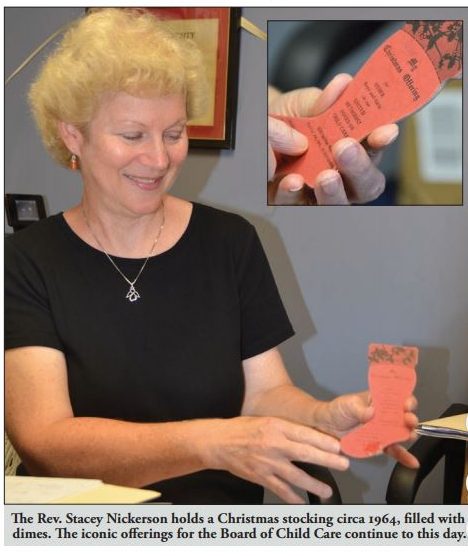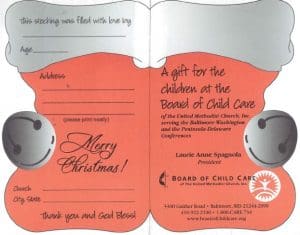
By Erik Alsgaard
UMConnection Staff (link to full newsletter)
If you grew up in the Baltimore-Washington Conference, you might remember, as a child, putting 10 dimes in a slotted, Christmas –stocking-shaped card. It was a way to give money to children who were being cared for by the Board of Child Care.

In the 1960s, this offering contributed about 60 percent of the operating budget of the Board, said the Rev. Stacey Nickerson, Director of Church and Community Engagement. Today, the red stockings are still around, but thanks to grants, contracts with various government agencies, and more, the offering is mainly used to help ensure the BCC children and their families have a Christmas.
The history of the BCC goes back to the late 19th and early 20th centuries. Three facilities, all with ties to the Methodist Church — the Kelso Home for Girls, Strawbridge Home for Boys, and Swartzell Methodist Home for Children — merged under one organizational structure, called the Board of Child Care.
After bringing all three of these independent organizations together, a way of funding the work was needed. Their initial suggestion was to have a Christmas offering for every church in the conferences (what is now the Peninsula-Delaware Conference was a part of the BCC in the early 1920s). In 1953, the annual conferences adopted the report of the merger and established the Christmas offering.
The genius of these stockings, Nickerson said, is that they allowed children in local churches to help other children in need. The Christmas stocking debuted, she said, in 1954. On the BCC’s Facebook page, they are collecting stories of adults who, as a child, filled those stockings.
“Over the years, it’s changed,” Nickerson said, noting that today’s stocking card holds quarters. “But I can go in a lot of United Methodist churches today and hold up that stocking and people are like, ‘Oh, you’re from there!’ It’s iconic.”
In addition to the stockings, the BCC also provides offering envelopes for people who wish to make monetary donations that don’t jingle.
 “I’d like to see churches take advantage of the Christmas offering more,” Nickerson said.
“I’d like to see churches take advantage of the Christmas offering more,” Nickerson said.Why?
“Because it’s a fantastic way for churches to connect with what we’re doing here,” she said, plus it helps teach stewardship, sacrifice, and more to both adults and children alike.
Nickerson, who has the nick-name this time of year, “The BCC’s St. Nick,” works with the youth in their residential programs to establish a Christmas wish-list. She then matches those lists with churches and other organizations that want to help. Sadly, there are still children who don’t get anything filled on their list.
That’s where Nickerson steps in. “I take the money that’s been raised through the stockings to go out and purchase what is needed,” she said. “Everyone gets gifts.”
Volunteers come in to wrap the gifts, and the children receive them on Christmas morning.
The BCC’s Auxiliary also hosts a Christmas store for families of residential youth, Nickerson said. That’s where youth can shop for gifts for their loved ones. “We’ve expanded that,” she said.
“We have a family store, so the families of our students at the school, residential facilities, clients in Pasadena and outpatient mental health, can go and select gifts for their families, their siblings, and others. It’s amazing.”
Note: Rev. Dr. Stacey Nickerson is no longer working at BCC, however the Development team still runs this historical and important Red Stocking Campaign each year. For more information on how to participate in the Red Stocking program, visit BoardofChildCare.org/Christmas
Read more from Red Stockings: a Board of Child Care legacy continues